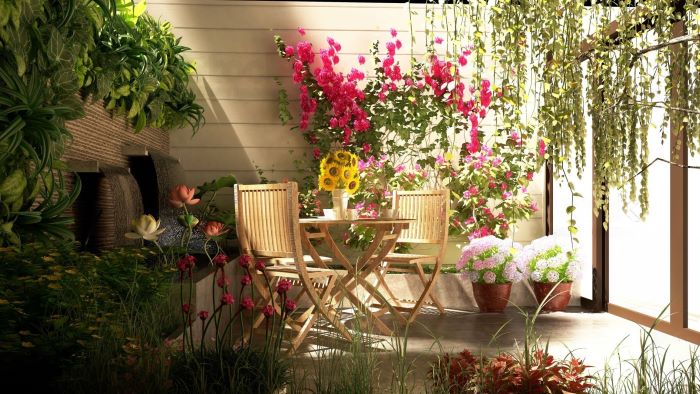Do you love gardening but feel like you don’t have enough space to grow your favorite plants? Do you wish you could turn your tiny outdoor area into a green paradise that will make your neighbors jealous? Well, if you answered yes to any of these questions, then this blog post, Tips for Designing a Small Garden Space, is for you.
In this post, I will share 10 tips for designing a small garden. These tips will help you make the most of your limited space and create a beautiful and functional garden that you can enjoy all year round.
So, are you ready to transform your small home garden space into a green oasis? Then read on and discover how to design your small home garden space that will wow everyone who sees it.🌱
Contents
- 1 10 Tips for Designing a Small Garden Space
- 1.1 1. Consider the Size and Shape of Your Space
- 1.2 2. Use Vertical Space
- 1.3 3. Create Focal Points to Design a Small Garden Space
- 1.4 4. Add Lighting to Enhance the Garden Space
- 1.5 5. Add Accents and Accessories for Interest
- 1.6 6. Incorporate Seating to Design a Small Garden Space
- 1.7 7. Use Color and Texture for Visual Impact
- 1.8 8. Use Mirrors to Decor Your Small Home Garden
- 1.9 9. Be Creative in Decor Small Garden Space
- 1.10 10. Keep Up With Low Maintenance Small Garden Design
- 2 FAQs
- 3 Conclusion
10 Tips for Designing a Small Garden Space
Whether it’s a balcony, patio, or courtyard, you can still create a beautiful and functional garden with some smart design tips. Here are 10 tips for a low-maintenance small garden design that will help you transform your outdoor area into a lush green oasis.
1. Consider the Size and Shape of Your Space
The first step to designing a small garden space is to measure your area and determine its shape. This will help you choose the right plants, containers, and furniture, which will fit and complement your space.

Let me explain to you with an example, if you have a long and narrow balcony, you may want to use tall and slender plants that will create a sense of height and depth. On the other hand, if you have a square or round patio, you may want to use round or oval containers, which will soften the edges and create a cozy atmosphere.
2. Use Vertical Space
Another way to design a small garden space is to use vertical space. In other words, you can use walls, fences, trellises, shelves, hanging baskets, or hooks to grow plants upwards instead of outwards. Furthermore, this will save floor space and create more visual interest in your home garden.

In addition, you can also use climbing plants such as ivy, clematis, or jasmine to cover bare walls or fences and add some greenery and fragrance to your space.
3. Create Focal Points to Design a Small Garden Space
Well, you can create focal points that will draw attention and create a sense of order and harmony in your garden. A focal point can be anything that stands out in your space, such as a colorful plant, a sculpture, a fountain, or a bird feeder. Plus, you can also use contrasting colors, shapes, or textures to create focal points that will pop against the background.
For example, you can use bright red geraniums against a white wall, or a metal birdcage against a wooden fence.
4. Add Lighting to Enhance the Garden Space
As we have seen, lighting is an essential element of designing a small garden space, as it can enhance the beauty and ambiance of your home garden at night. You can use different types of lighting to create different effects in your garden, such as fairy lights, lanterns, candles, or solar lights.

Plus, you can also use lighting to highlight your focal points or create a romantic mood in your garden. To create such a vibe, all you need to do is use fairy lights to wrap around your trellis hanging baskets, or lanterns to illuminate your seating area.
Related Post: Gardener Tips and Tricks!; Tips for Watering Plants!
5. Add Accents and Accessories for Interest
To design a small garden space that is not boring or bland, you can also add accents and accessories that will add personality and interest. These can be anything that reflects your style and taste, such as cushions, rugs, pillows, statues, wind chimes, or signs.
Plus, you can also use accents and accessories to add some color and texture to your space, such as colorful pots, baskets, or fabrics. Just make sure not to overdo it and clutter your space with too many items.
6. Incorporate Seating to Design a Small Garden Space
If you want to enjoy your small garden space and relax in it, you should incorporate some seating that is comfortable and practical. So, to get such seating, you can choose from different types of seating depending on your space and needs. Such as chairs, benches, stools, or hammocks.

Furthermore, you can also use multifunctional seating that can double as storage or planters, such as ottomans or boxes. Moreover, you should consider the size and shape of your seating and how it will fit in your space without taking up too much room.
7. Use Color and Texture for Visual Impact
Color and texture are two elements that can make a big difference in designing a small garden space. They can create contrast, depth, movement, and mood in your space. You can use color and texture in different ways in your garden, such as through plants, containers, furniture, fabrics, or accessories. Additionally, you can also use color schemes that will suit your space and style, such as monochromatic (one color), complementary (opposite colors), or analogous (similar colors).
8. Use Mirrors to Decor Your Small Home Garden
Mirrors are another great way to design a small garden space that will make it look bigger and brighter. It can reflect light and create an illusion of depth and space in your garden. Plus, you can use mirrors of different shapes and sizes in your garden, such as round, square, or rectangular.

Moreover, it’s a good idea to use mirrors with frames that match your garden theme, such as rustic, modern, or vintage. To give a cozy look it’s the best option to hang mirrors on walls, fences, or trellises, or lean them against planters or furniture.
💭How to keep your indoor plants healthy?
9. Be Creative in Decor Small Garden Space
One of the most fun and rewarding tips for designing a small garden space is to be creative and use your imagination. In other words, use items that you already have or find in thrift stores, flea markets, or garage sales to create unique and original features in your garden.
For example, you can use old tires, buckets, or crates as planters or old ladders, pallets, or doors as shelves. You can also repurpose items not meant for gardening, such as teapots, shoes, or umbrellas, as planters or accessories.
10. Keep Up With Low Maintenance Small Garden Design
The last tip for designing a small garden space is to keep up with maintenance and care for your plants and garden. This will ensure that your garden looks neat, healthy, and beautiful all year round. For that, you should water your plants regularly and according to their needs, prune them when needed, remove dead or diseased leaves and flowers, fertilize them occasionally, and protect them from pests and diseases. You should also clean your containers, furniture, and accessories from time to time and remove any weeds or debris from your space.
FAQs
How do I make a garden plan layout?
To make a garden plan layout, you need to consider the following factors. The size and shape of your space, the sun exposure and soil quality, the plants you want to grow, and the design style you prefer. You can use graph paper, online tools, or apps to sketch your layout and label the plants, paths, and features. Plus, you can also use symbols, colors, or codes to indicate the plant types, heights, and spacing.
What is the most effective garden layout?
The most effective garden layout depends on your goals, preferences, and conditions. However, some general principles that can help you create an effective garden layout. Such as choosing plants that suit your climate and soil, and grouping plants with similar needs together. Or rotating crops to prevent pests and diseases, using raised beds or containers to improve drainage and accessibility, and incorporating vertical gardening to save space and increase yield.
How to grow corn in a small garden?
Corn is a crop that requires a lot of space, sun, water, and nutrients to grow well. However, you can still grow corn in a small garden if you follow these tips: choose a dwarf or short-stalked variety that matures quickly, plant corn in blocks rather than rows to ensure pollination, water corn deeply and frequently to prevent wilting and stress, fertilize corn regularly with a high-nitrogen fertilizer to boost growth and production, and harvest corn when the kernels are plump and milky.
Conclusion
Creating a small garden space can be challenging, but also rewarding. By following these 10 tips, you can design a small garden space that is beautiful, functional, and enjoyable. You can also express your personality and style through your garden and make it a reflection of yourself.
Basically, you don’t have to settle for a boring or bland small garden space. You can make it a vibrant and lively place that will brighten up your day and bring you joy.
I hope you found these small garden ideas helpful and inspiring. If you did, please share this post with your fellow gardeners and leave a comment below. I would love to hear from you and see how you designed your small garden space.
Thank you for reading and happy gardening! 🌼

Hello, I’m Rose Lehman, the content writer of cozynest. I have been a gardener for over 5 years, and I have a certificate in master gardening from the Oregon State University Extension Service. I enjoy writing about all aspects of gardening, from the basics to the advanced, and from the practical to the creative. I also love to explore different types of gardens, cultures, and styles, and share them with our readers. My goal is to inspire and inform our audience, and help them grow their own cozynest.

